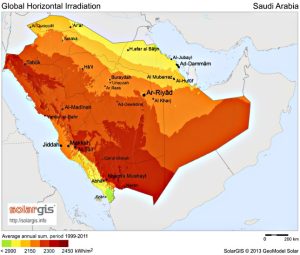Techno-economic assessment of concentrated solar power generation in Saudi Arabia
Saudi Arabia plans to shift a large portion of its domestic energy production away from fossil fuel towards solar energy by 2030. Yet, the solar energy pool is mainly targeting photovoltaic technology. This study analyzes the potential of cleaner energy production from solar energy using concentrated solar power technology. First, different locations for concentrated solar power technology deployment are assessed based on potential development opportunities, solar resources, and infrastructure. Second, the paper assesses the performance and financial feasibility of four concentrated solar power technologies using the capacity factor, levelized cost of energy, and energy yield. The analysis indicates that all the considered locations are suitable for concentrated solar power technologies with a preference for the NEOM city located in the northern region of Saudi Arabia. The simulation results revealed that solar tower technology produces the highest energy yield of 2738 kWh/kW. The levelized cost of energy for the four technologies varies between 14.54 – 22.67 ¢/kWh, with linear Fresnel demonstrating the lowest and parabolic trough exhibiting the highest levelized cost of energy.
Introduction
Saudi Arabia relies heavily on fossil fuel-based power plants to satisfy energy requirements [1]. Currently, Saudi Arabia satisfies local energy demand with oil production as it is considered to be one of the leading oil producers in the world, with oil revenues making up around 90 % of its economy. However, the sustainability of the domestic power supply model will be very difficult in the coming years with mounting pressure to satisfy the rapid increase in annual demand. Saudi Arabia is highly motivated to increase solar energy production in its energy mix plans. Saudi Arabia owns proven oil and gas reserves worldwide with around 266 billion barrels of crude oil and 8.3 trillion cubic meters of gas [2]. Therefore, leveraging the capacity of Saudi Arabia’s solar energy will reduce a certain portion of oil and gas consumption domestically and increase oil and gas exports. Crude oil is perhaps one of the most valued commodities in today’s industrialized economy. Local oil daily demand is about 0.7–0.9 million barrels with a large portion to meet electricity demand [3]. Saudi Arabia intends to increase its electricity production capacity to 120 GW by 2030 in response to the rapid growth in electricity demand [4,5]. Saudi Arabia strives for cleaner types of energy that have either a reduced or zero impact on the environment and are sustainable for the coming generations.
Utilizing solar energy for power generation will reduce dependency on fossil fuel and lead to a significant reduction in ambient air pollution and greenhouse gas emissions which will help Saudi Arabia to meet its international agreement targets and its 2030 Vision [6]. Oil price fluctuations present a risk to sustainability and growth in the long term as fossil fuel prices have faced significant fluctuations and rapid declines over the years. The most recent price fluctuation is the drop in the oil price from 100 USD in 2014 to less than 20 USD in 2020, which has resulted in budget deficits in recent years [7]. The country then decided to aggressively diversify its economy and invest in other forms of renewable and clean energy to minimize its reliance on fossil fuel and allow more fossil fuel to be used for exports and value-added industries.
Saudi Arabia has not fully exploited the huge potential of renewable energy such as solar power. The countries located along the ‘sunbelt’ area have high sunlight intensity and thus receive a solar energy of about 5–9 kWh/m2 per day [8]. Saudi Arabia is blessed to lie at the center of the “sunbelt” between latitudes 16° and 33°N and longitudes 34° and 56°E [9]. Although Saudi Arabia has ambitious targets for generating electricity through photovoltaic panels (PV), the country still has huge unexplored potential to establish Concentrated Solar Power (CSP) which may contribute to around 125,260 TWh/year, which is expected to meet a high portion of the energy demand [10,11]. Saudi Arabia’s energy outlook can accommodate efficiently both technologies in solar power generation: PV and CSP. The only limitation of the CSP technology is that economic benefits can be demonstrated clearly in large-scale projects, compared to PV projects which can be feasibly scaled down to smaller projects [12]. The huge demand for energy in Saudi Arabia indicates that there is strong market demand for solar power generation in large-scale projects such as CSP plants. There are four different types of CSP technologies, namely, parabolic trough, solar tower, linear Fresnel, and parabolic dish.
Several studies have assessed the technical and economic potential of CSP technology around the world. Purohit and Purohit [13] conducted the technical and economic feasibility analysis of power tower and parabolic trough technologies in different locations across India. The study found that the northwestern part of the country outperformed other regions. Agyekum et al. [14] evaluated the solar tower and parabolic trough technologies in Ghana. The levelized cost of energy (LCOE) ranges between 13.67-14.73 ¢/kWh and 25.80–28.83 ¢/kWh for the solar tower and parabolic trough, respectively. Trabelsi et al. [15] studied the performance of a parabolic trough with wet and dry cooling systems under the climate conditions of the southern region of Tunisia. The study concluded that wet cooled CSP plants outperformed dry cooled plants in terms of LCOE and annual net electricity generation.
Aghahosseini et al. [16] explored the Middle East and North Africa (MENA) countries’ targets and plans to exploit renewable energy until 2030. Trieb et al. [17] reported that the North African countries have a high potential for CSP deployment for commercial applications. Purohit and Purohit [18] assessed the technical and economic potential of CSP deployment in 591 locations across India, considering various ranges of annual Solar Direct Irradiation (DNI) and wind power density. Ummadisingu and Soni [19] explored the potential and policies for energy generation using CSP technologies in India. Sultan et al. [20] evaluated the parabolic trough technology for energy generation in Kuwait. The proposed plan was benchmarked with an existing plant in Spain. The study found that the proposed plant outperformed the Spain plant in terms of overall efficiency, annual net electricity output, and LCOE.
Shouman and Khattab [21] studied the economic potential of CSP technology for electricity generation in Egypt. Mohammadi and Khorasanizadeh [22] assessed the financial feasibility of employing CSP in Iran. Ghaithan et al. [23] assessed the integration of solar energy with water desalination. Hirbodi et al. [24] conducted a feasibility analysis of deploying parabolic trough and solar tower power plants in the south-central regions of Iran. The study examined the impact of solar multiple, plant capacity, storage time, and type of cooling system on the optimal configuration. Aly et al. [25] examined the viability of introducing a parabolic trough and solar tower in Tanzanian. The study revealed that the LCOE using the solar tower is lower than the parabolic trough. Wang et al. [26] assessed the technical and economic of a solar receiver employed in a CSP plant using a heat collection model. The study found that including such a novel solar receiver improves net annual electricity production by 9.77 % and reduces the LCOE by 8.67 %. Abaza et al. [27] simulated a 10 MW solar power plant employed with three power blocks namely, steam rankine cycle, open gas cycle, and organic rankine cycle using ASPENHYSYS software. Recently, Liu et al. [28] conducted a technical and economic feasibility analysis of thermal storage for CSP using the Monte Carlo simulation method to address t the technical input parameters uncertainty.
Several researchers have explored the potential of CSP technologies for electricity generation around the world. Nevertheless, there is a need for assessing both potential locations and the feasibility of CSP technologies, especially in the Middle East countries. Energy investors attempting to undertake projects in Saudi Arabia encounter obstacles due to insufficient feasibility studies on both potential locations and suitable CSP technologies. Consequently, the novelty of this study stems from two main aspects. Firstly, it involves assessing different locations for CSP deployment based on potential development opportunities, solar resources, and infrastructure. Secondly, the study analyzes the feasibility of energy generation from different CSP technologies namely, parabolic trough, solar tower, linear Fresnel, and parabolic dish. The performance and financial feasibility of considered CSP technologies were compared based on capacity factor, monthly energy production, amount of energy yield, and LCOE. In the next section, the followed research methodology will be discussed in details.
Section snippets
Materials and methods
This research primarily aims to assess different locations for deploying CSP technologies in Saudi Arabia. In addition, it evaluates the performance and financial feasibility of CSP technologies such as parabolic trough, solar tower, linear Fresnel, and parabolic dish based on capacity factor, amount of energy yield, and LCOE. Fig. 1 demonstrates the flowchart of the steps used to conduct this study.
Initially, four potential locations in Saudi Arabia for establishing solar power technology will
Results and discussion
In this study, four different potential locations are assessed based on the availability of solar resources, an acceptable level of infrastructure, and potential development opportunities in terms of mega-projects. The outcome of the assessment is used to identify the best location for CSP technologies installation. Then, the performance and financial feasibility of the four CSP technologies will be evaluated using SAM software with the aim of selecting the best CSP technology for Saudi Arabia.
Conclusion
One of the major obstacles to solar power deployment is the high investment costs and its ability to be economically feasible. However, in recent years, the initial costs have dropped significantly which will make CSP technologies feasible at certain tariff levels. This study assessed the potential of several locations for CSP technologies deployment in Saudi Arabia based on solar resources, infrastructure, and potential development. The analysis aims to identify the best site for deploying the
Data availability
The data that support the findings of this study are available from the corresponding author upon reasonable request.
CRediT authorship contribution statement
Ahmed Ghaithan: Conceptualization, Methodology, Software, Data curation, Writing – original draft, Supervision, Writing – review & editing, Formal analysis. Laith Hadidi: Software, Validation. Awsan Mohammed: Visualization, Investigation, Writing – review & editing.
Declaration of competing interest
The authors declare that they have no known competing financial interests or personal relationships that could have appeared to influence the work reported in this paper.
Acknowledgement
The authors acknowledge the help provided by the King Fahd University of Petroleum and Minerals represented by the Research Center on Smart Mobility and Logistics under the project number: INML2203.
References (81)
- et al.
Electricity generation analyses in an oil-exporting country: transition to non-fossil fuel based power units in Saudi Arabia
Energy
(2014) - et al.
Renewable and sustainable energy production in Saudi Arabia according to Saudi Vision 2030; Current status and future prospects
J. Clean. Prod.
(2020) - et al.
The status of renewable energy in the GCC countries
Renew. Sustain. Energy Rev.
(2011) - et al.
The techno-economic potential of Saudi Arabia׳s solar industry
Renew. Sustain. Energy Rev.
(2016) - et al.
Assessing current and future techno-economic potential of concentrated solar power and photovoltaic electricity generation
Energy
(2015) - et al.
Techno-economic evaluation of concentrating solar power generation in India
Energy Pol.
(2010) - et al.
Optimization and techno-economic assessment of concentrated solar power (CSP) in South-Western Africa: a case study on Ghana
Sustain. Energy Technol. Assessments
(2020) - et al.
Techno-economic performance of concentrating solar power plants under the climatic conditions of the southern region of Tunisia
Energy Convers. Manag.
(2016) - et al.
Towards sustainable development in the MENA region: analysing the feasibility of a 100% renewable electricity system in 2030
Energy Strategy Rev.
(2020) - et al.
Technical and economic potential of concentrating solar thermal power generation in India
Renew. Sustain. Energy Rev.
(2017)



